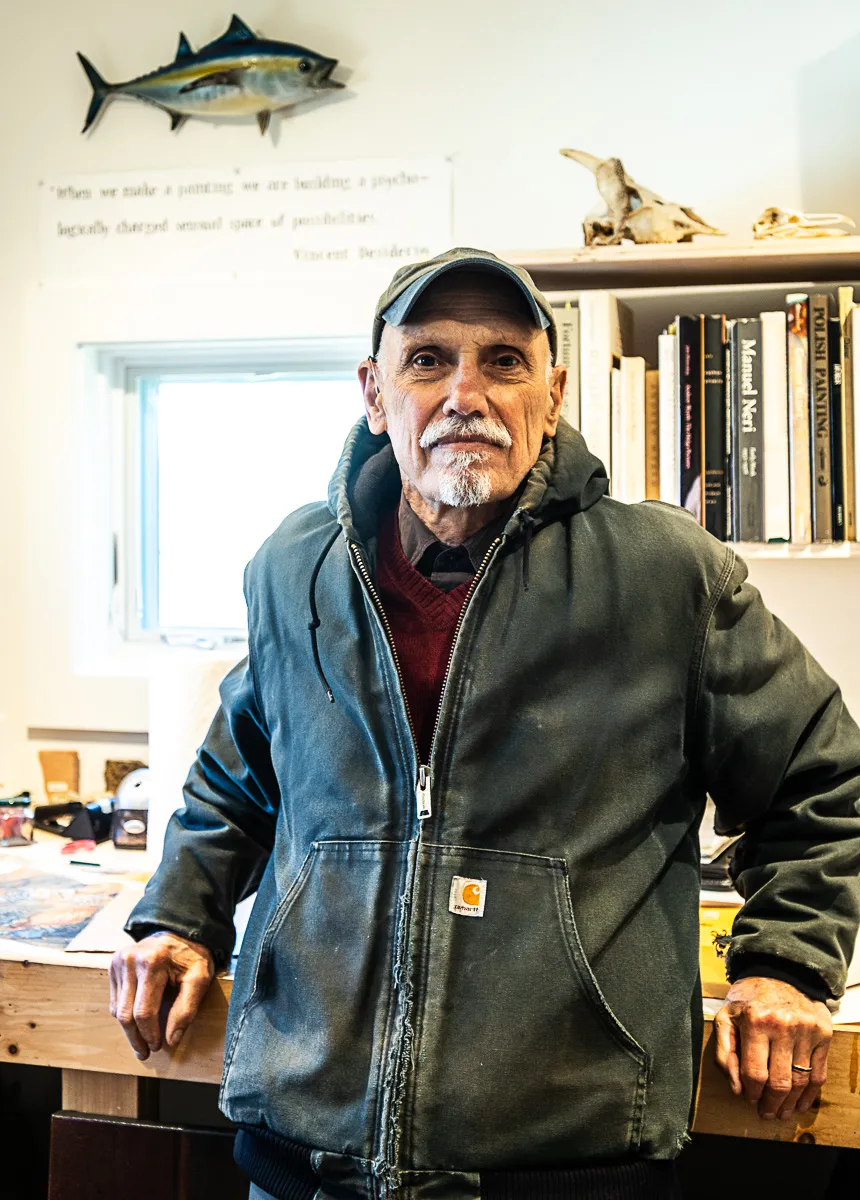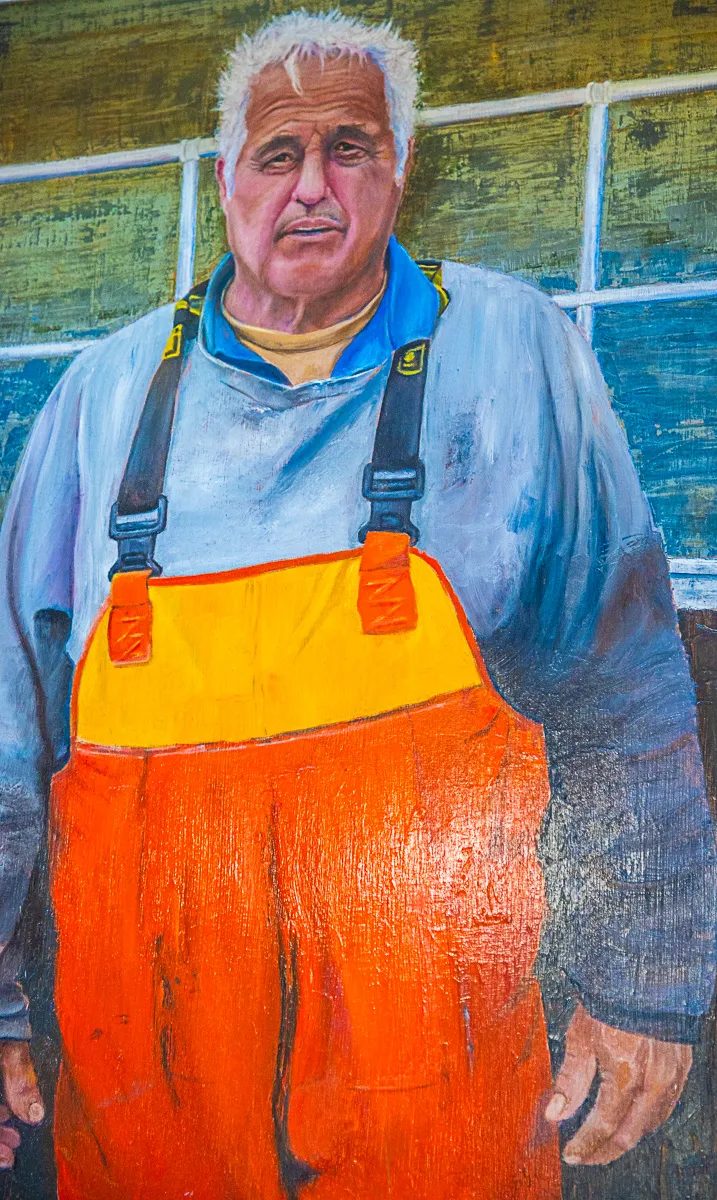“I love Maine. Lobstering’s part of Maine. Lobstering’s threatened. And I just want to honor the lobstermen.”
So said Bailey Island artist Dennis Wilkins, who often walks the quarter-mile from his home on Abner Point to Glen’s Lobsters, the place where he buys his “critters.” It was there he conceived of the project that he hopes will raise awareness of the ongoing challenges facing the lobster industry.

“They’re under multiple stresses — climate change, regulations … It’s like the world’s coming down on them,” Wilkins said. “I want them to see that they’re recognized … they’re appreciated, so much so that I’m going to spend time to paint their portraits and give them to them.”
Wilkins, a retired neurologist and self-trained fine artist, started working on the project in June 2023. He acquired permission to approach lobstermen unloading their catch at Glen’s Lobsters and decided to paint portraits of the first six who agreed to participate.
George Coffin, Chuck Leeman, Bernie Johnson, Clayton Gilliam, Brandon Wyman, and Craig Rogers all said yes.
Rogers, a fourth-generation lobsterman, thinks he may be the last of his family to work in the fishery. While the lobster industry helped him raise three sons, he hopes they choose a different path.

“Not just lobstermen but draggers in the industry are in dire straits,” he said during an interview at his fish house on Orr’s Island.
Rogers cited “a lot of regulations from people who have no idea what our business is or what it entails” among his frustrations. Restrictions like those put in place to protect the endangered North Atlantic right whale, as well as plans for offshore wind turbines and limits on the availability of bait species, are all issues that Rogers said are negatively impacting the ability of lobstermen to earn a living.

“All the restrictions that are being dumped on us (are) making it more and more and more difficult just to go lobstering,” he said. “And it’s a fight that … I don’t know if we can win it.”
For Rogers, lobstering is more than just a way to earn a living. It’s an integral aspect of his upbringing and a connection to lessons passed down from his father and grandfather.
“My dad would say, ‘OK, you kids want to go fishing? Go patch up some of my old wooden gear and take out your skiff and row out and set ’em. Don’t leave the cove though, so I know where you are.’ So that’s how it all started,” Rogers said.
As an adult he learned to value the independence of his chosen career, the ability to manage his schedule so he could be present for his own children.
“I don’t think I’ve missed a baseball game or soccer game or anything like that with my kids,” he said. “You work a little harder today so that you can go to the ballgame tomorrow.”
Still, it can be a tough way to make a living. The work is hard and the income uncertain.
“You get up in the morning and it’s 20 degrees and you’ve got to haul your traps because weather conditions may not be great for the next few days,” Rogers said. “And the income — you can’t plan ahead when you’re a lobsterman. … It’s tough. There’s some times when you shake your head … and then there’s times you think you’ve landed on the moon.
“When it all shakes out, you just think back and say, ‘Well, you know what? This isn’t such a bad thing … I’ve raised a family (and) I don’t have to answer to anybody. Except for the wife.”
Rogers met Wilkins near the end of his workday, as he arrived at Glen’s Lobsters to unload his catch. He paused for a moment so Wilkins could snap a picture.
He’s seen the completed portrait.
“I think he did a good job,” Rogers said. “He pretty much caught all the features.”
Those features are what Wilkins wanted to preserve, the faces of six men who, for him, represent the face of an industry, of its history and future.
Wilkins completed the final portrait in the series in February. Each 2-by-3 oil-on-canvas portrait took him about 50-60 hours to paint.
While he was pleased that his approach netted a range of ages, he noted that the lack of women unloading during the time he spent on the wharf limited his ability to capture their contribution to the industry.
For Wilkins, the project is already a success. His subjects are pleased with the work, one of them even declaring that the painting would become a family heirloom.
A planned one-day showing at the Orr’s Island Schoolhouse is like “icing on the cake,” Wilkins said. “Certainly all the lobstermen know, and I hope they will come with their friends and families.”
He hopes the residents of Harpswell will come as well — to see the work and to show support for the men and women who make their living trapping the state’s iconic crustacean.
Wilkins’ portrait series can be viewed at the Orr’s Island Schoolhouse from 1-4 p.m. on Sunday, June 16. Wilkins will speak at 3:30, then the lobstermen will take their portraits home.
Bisi Cameron Yee is a freelance writer and photojournalist based in Midcoast Maine whose work has appeared in The Lincoln County News, the Bangor Daily News, the Boothbay Register, and The Maine Monitor. She holds an associate degree in photojournalism.
This story originally appeared on harpswellanchor.org and has been republished here with permission.






